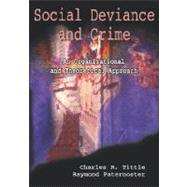Social Deviance and Crime An Organizational and Theoretical Approach
, by Tittle, Charles R.; Paternoster, Raymond- ISBN: 9780195329957 | 0195329953
- Cover: Hardcover
- Copyright: 4/4/2000
Social Deviance and Crime unites two topics that are usually separated: the study of social deviance and the study of criminal behavior. Traditionally, the study of deviance introduces students to various types of deviance, giving the impression that these are distinct acts requiring equally distinct and unique explanations. The study of crime has followed virtually the same path. Criminology textbooks usually describe a series of criminal acts, one at a time, fostering the impression that these acts have only one thing in common--they are all violations of the criminal law. As a result, treatment of deviance and crime in most texts has proceeded along two different and parallel tracts, with little or no convergence. In Social Deviance and Crime , Tittle and Paternoster contend that acts of social deviance and criminality share important conceptual ground: both are types of behaviors that are socially disapproved, and specific acts differ mainly in the degree to which they are disapproved. The authors argue that social disapproval is an important characteristic that links apparently diverse behaviors (religious and sexual deviance, organized crime, youth gangs, drug use, serial murder, etc.). This book differs significantly from other texts in the way it bridges deviance and crime within a single conceptual and explanatory framework. Social Deviance and Crime's approach is also unique. Texts in criminology and deviance often adopt either an "interactionist/constructionist" or a "substantive" perspective. This book treats deviance as an integrated concept, differentiated chiefly by how well deviant/criminal enterprises are organized. The authors describe and analyze different types of deviant/criminal acts according to an ascending scale created by combining nine different features of organization. The text then explores theories and explanations about how deviance takes place, how it develops, and why it is maintained. Also included is a discussion of variations in the distribution/rate of deviant acts within society, and how theory can and cannot account for these known variations. Tittle and Paternoster interweave conceptual and empirical material together, giving students an opportunity to understand the impact of theory on research. Every chapter features Deviance in Everyday Life boxes. Here, the authors provide vivid, real-world examples of deviance, deviance organization, and attempts by society to "do something about" deviance.






